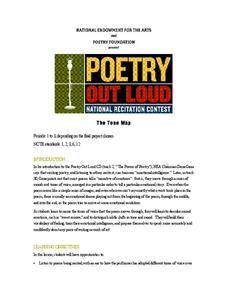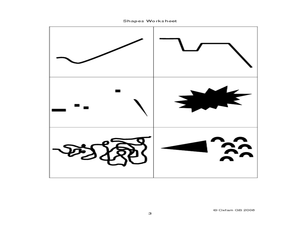Curated OER
The Tone Map
Poems are meant to be heard. Hearing a poem being read enriches one’s understanding of the tone and mood of the piece. Introduce your class to the sounds of poetry with a packet that not only details how to use poetry recordings in the...
Southern Nevada Regional Professional Development Program
Reading Literature - An Occurrence at Owl Creek Bridge
“An Occurrence at Owl Creek Bridge,” Ambrose Bierce’s short story, is used to model how structural moves, the decisions an author makes about setting, point of view, time order, etc., can be examined to reveal an author’s purpose. Groups...
Brigham Young University
Understanding Design, Composition, and Color
The set for a play combines design elements (style, line, shape, mass, measure, position, color, and texture) and principles of composition (unity, harmony, contrast, variation, balance, proportion, and emphasis) to create a particular...
Teaching Tolerance
Using Photographs to Teach Social Justice | Exposing Gender Bias
Young sociologists are asked to read two photographs, identifying how the photographer uses point of view, color, pose, light, and shadow to express a stereotype of women or to challenge those stereotypes. Partners then create their own...
Hawaiʻi State Department of Education
Suki's Kimono
In the story Suki's Kimono drums are used to show mood. Learners discuss mood in the story after they practice playing a simple 4/4 rhythm on their drums. Each group plays the rhythm using a different tempo. They listen to each other...
Institute of Electrical and Electronics Engineers
Try Your Hand at Nano
Fascinating reading about nanotechnology, nanoscale properties, and liquid crystals precedes a fun activity for young engineers. They measure their hands in nanometers, research, and then investigate how heat effects a sheet containing...
Curated OER
Connotation and Denotation: How Word Choice Affects a Paragraph
Review the terms denotation, connotation, diction, and mood in paragraph writing. After defining the terms, middle schoolers practice writing examples of both connotation and denotation. They complete a connotation and denotation graphic...
Curated OER
It's All About Expression: Growing Independence and Fluency
In an engaging anticipatory set, the teacher uses several different strategies to activate prior knowledge about reading with expression, including using sentence strips (that must be prepped ahead of time) to show different moods. The...
Curated OER
Don't Be Silly–Expression is Fun!
As children observe the teacher reading Today I Feel Silly and Other Moods That Make My Day, they take note of the role punctuation plays in the emotion or expression used. They then take turns reading a book with a partner so they can...
Curated OER
Perceiving Place
Students observe how color creates the mood of a place, and generate sketches and drawings that capture their observations.
National Endowment for the Humanities
Emulating Emily Dickinson: Poetry Writing
High schoolers analyze mood and voice in Emily Dickinson's poem, "There's a Certain Slant of Light." After the analysis, students write a poem of their own emulating the Dickinson poem, and then write a one-page essay describing what...
Curated OER
What Kind of Ladybug Are You?
As a class, read different sentences prepared by the teacher, identifying the punctuation that is needed for the appropriate expression. In small groups, have each child assume the role of one or more character in The Grouchy Ladybug by...
Huntington Library
Light in Painting
How do painters use and manipulate light in their artwork to give emphasis and establish mood and emotion? Pupils will analyze a few examples of landscape and portrait painting in order to explore the how light is used in art, and will...
Curated OER
Bud, Not Buddy: Guided Imagery Exercise
Develop readers’ awareness of the visual power of language with a guided imagery exercise. Set the stage and create the mood with dim lights, soft music and potpourri. Then read the provided section of Bud, Not Buddy. Next, invite...
Hawaiʻi State Department of Education
Pilobolus
After reviewing dance-specific terminology and watching a clip from the dance troupe Pilobolus, learners create dances of their own. They pair up and use the teacher's cues to create creature dances that exemplify mood and shape. Any...
The New York Times
Collateral Damage? Researching a Connection Between Video Games and Violence
Hook your class into an exploration of and discussion about violence in video games with a cute animal clip and a video game trailer. After a quick discussion about how media can affect mood, class members read a related article and...
Curated OER
Painting Music
Students convey the concept that music expresses different moods. Using paint, students draw various artistic elements that convey the mood of a piece of music they hear in class. They complete an analysis of classical paintings and how...
Curated OER
Self-Portraits
Sixth graders create self-portraits. In this visual arts instructional activity, 6th graders examine the relationship between mood and color value in pieces of art. Students create self-portraits that convey mood using cut paper and glue.
Curated OER
Language Conventions: Elements of a Good Log Entry
Students use writing logs to achieve clear and creative thinking about the story they are reading. They then describe changes in mood that happened in the story consider why such changes usually occur.
Curated OER
I Like It: Discovering Your Personal Style
Students explore design options and styles to discover their personal style. In this personal style instructional activity, students reflect upon personal taste and style preferences and explore the link between color and mood. Students...
Curated OER
The Importance Setting and Mood in Fiction
Seventh graders examine the setting in pieces of fiction. In this story analysis lesson plan, 7th graders investigate the setting in fictional stories and the importance it has. Students discover new vocabulary terms applying to...
Curated OER
Design a Book Cover
Students explore character, plot, setting, symbolism, and conflict for a book that they are reading. Sample book covers are provided and students apply what they have learned by designing a book cover.
Curated OER
Global Music Patterns- Islamic Art
Students compose music using Islamic patterns. In this cultural arts lesson, students examine Islamic art and analyze the patterns. Students incorporate various Islamic patterns into a musical composition.
Curated OER
Mood In Art And Poetry
Seventh graders investigate the concept of mood and how it influences various types of art. They create an abstract painting and demonstrate how mood is present in the work. Also, 7th graders construct poems using word choices to set...
Other popular searches
- Descriptive Words for Mood
- Mood and Tone
- Mood and Tone Worksheet
- Tone Mood
- Teaching Mood and Tone
- Author's Tone and Mood
- Colors Conveying Mood
- Mood in Literature
- Identifying Mood
- Analyzing Tone and Mood
- Spanish Grammar Subjunctive
- And Mood

























